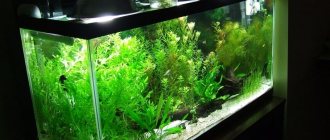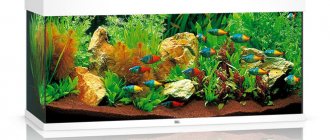Aquarium care consists of a number of procedures that are carried out according to a schedule. A clear schedule of these routine actions maintains a constant microclimate in the aquarium, and this has a positive effect on the inhabitants of the aquarium, their behavior and their health. An aquarium timer simplifies aquarium maintenance by partially automating routine actions.
- Smart aquarium
- Types of timers for aquariums
- Electromechanical timer
- Aquarium timer in the form of a socket
- How to setup
- Using an aquarium timer
- Tips and warnings
- Video: making a timer for an aquarium with your own hands
- Video review of a mechanical timer
Rules for caring for aquariums: free
Smart aquarium
Using various aquarium maintenance devices, you can create a truly smart aquarium that will not require maintenance. Aquarium fish and plants, or rather, watching them, certainly provide aesthetic pleasure. But a real aquarist enjoys his own aquarium and fiddling with it, for example, replanting plants and cleaning water.
A complex smart aquarium is a complex engineering structure. The first step to a smart aquarium is to set a number of devices that serve it to work on a schedule. Do-it-yourself timers are designed specifically for this purpose.
So how much light do aquatic plants need?
Some believe that the optimal value for most plants is 50 lumens per 1 liter...
...but “a liter of water under the surface” and the same “liter at the bottom” will receive different amounts of light (Lux)!!!. It is important how well the leaves of the plants are illuminated, and not how well our lamps shine above the aquarium.
You can’t do without experiments, but you can safely focus on the indicators determined experimentally by Western aquarists. It is so determined that:
- 15,000 lux is quite enough for superficial light-loving plants (floating on the surface and growing at a depth of up to 10 cm).
- 10,000 lux - for those located in medium water columns
- 3000 lux - for soil rocks that do not require high performance.
Types of timers for aquariums
Aquarists use conventional timers, that is, devices that “monitor” the turning on and off of light sources or other electricity consumers according to a schedule. Timers are used for devices in the aquarium (for example, a compressor, aerator, lamps):
- electromechanical;
- electronic.
The choice of the type of timer depends on how long the aquarium is left unattended and on the funds that you would not mind spending on its purchase, since the price of electronic timers is significantly higher than electromechanical ones.
Electromechanical timer
This timer works on the principle of a clock mechanism. The power on and off times can be adjusted for one day. Setting up such a device will not be difficult. The timer usually has levers to indicate the on and off times and a dial with a time scale. To configure, follow a few simple steps:
- Bend the levers and set the on and off times.
- Turn the dial to set the current time (it should be indicated by a triangular mark).
- The timer is plugged into the outlet and the device for which the operating period has been set is connected to it.
This timer is easy to set up and operate, but it also has some disadvantages:
- relatively short service life (compared to electronic timers) due to the presence of mechanical parts that wear out quickly;
- setup is possible within one day;
- when the power is turned off in the household network, the program is interrupted for the duration of the power outage;
- ticking sound.
Aquarium timer in the form of a socket
An electronic timer is usually a socket with a display and buttons for setting it. Different timer models differ in the number of possible settings. Typical electronic timer settings:
- separate settings for different days of the week;
- setting the program to turn on with a delay (usually for up to one day);
- repeating the cycle for the required number of days.
Any electronic timer has a built-in rechargeable battery (or battery), which prevents program failures during a power outage.
How to setup
Setting up an electronic timer should not cause problems, since detailed instructions for setting up and programming the timer are included with each specific model. General principles for setting up an electronic timer:
- The current date and time are displayed.
- Sets the on and off times.
- The program applies to a specific day of the week.
- Steps 2 and 3 are repeated for each day of the week.
So luxes or lumens? - you ask
Lumens amount of light from a source, and we will need this in our calculations. And we will count luxes - units for calculating illumination (1 Lux is equal to the illumination of a surface of 1 m2 with a luminous flux of radiation incident on it equal to 1 Lumen).
It is important to choose accurate indicators without any “reserves”. If a lack of lighting slows down the assimilation processes in plants, inhibits their growth and can even lead to death, then due to overestimated parameters, plants can:
- receive harm from excess light , which leads to the decomposition of chlorophyll, destruction of plant protoplasm and nutritional imbalance.
- accept attempts at “self-defense” - by reducing the area of the leaf plate and lowering our leaves into the depths of the water - which we definitely do not achieve
- or vegetate wildly (grow uncontrollably).
So that they can grow quietly for a long time and do not change the underwater landscape you created, but at the same time do not degenerate - select the lighting characteristics correctly.
Using an aquarium timer
The main concern of the aquarist is the health and vitality of its inhabitants. This means creating an environment in the aquarium that is as close to natural as possible. The most obvious use of a timer is to turn the aquarium lights on and off according to daylight hours. The timer to which the light source is connected is set to operate for 8-12 hours (depending on the time of year). The light source can be, for example, a sealed LED strip. You can secure it under the aquarium lid using glue and sealant.
Natural light sources are the sun and the moon. For the comfortable existence of some species of fish, moonlight is no less important than daylight. Similar to daylight, you can adjust the operating time of a specialized blue lamp that imitates moonlight.
The next step might be to hook it up to a timer compressor for aeration. Compressors operating without interruption very quickly exhaust their service life and break down. To extend the service life of the compressor, it is connected to a timer, which is set to operate continuously throughout the day, but with several breaks (three or four hour breaks per day are enough).
It is more difficult (but possible!) to automate the daily replacement of part of the water in the aquarium to simulate the environment of flowing water bodies. To do this, you can set a timer to turn on the pump that drains water into the sewer for some time every day. The exact operating time of the pump is determined experimentally so that 10-15% of the water is drained. Adding water is organized through a float chamber located inside the aquarium. A regular plumbing float can handle adding water. Although such a float is quite safe from the point of view of a possible overflow of water, it is still better to set the operating time of the timer that controls the pump for the time when someone is at home, and turn it off altogether during a long absence.
What lamps are needed for such requirements?
You need to start the calculation with the dimensions and displacement. More precisely, you need to start not from the displacement, but from its surface area (or bottom, as is more convenient for you). And let's forget about W/l . Using the table as an example of popular sizes, you can calculate the required lamps for a 100 liter aquarium.
We will consider the most significant length of the façade glass along the longest side, because There are international standards for linear lamps, and it is critical that they are not longer or shorter than the dimensions of the aquarium itself.
*Rounding up is due to leaving room for the base of your lamp.
Calculation example. So for a 100 liter aquarium with sides 350x600x500 mm, based on illumination standards and a surface area of 0.21 m2 for plants of average height (up to 25 cm), we find the value of 2100 Lumens.
In the online store, we select the parameters closest to 2100lm and see: in our case, the choice is a lamp with a length of 590mm (the closest along the length of the aquarium is 600mm) with a power of about 20 to 30W.
If the required denomination is not found, which is guaranteed for large dimensions, then we simply select smaller values and in larger quantities.
And in another example: under the same conditions, but for a large displacement of 1500 liters, where more than 16,000 lumens may be needed, 3 bright lamps of 5200 lumens (the maximum available) each will do.
Most aquariums are already equipped with a standard lamp in the lid. This is good because everything has already been done and you are deprived of the hassle of making it. But along the way, you also lose the opportunity to change the lamps of your choice , because... Ballasts (ballasts) only work with installed lamps.
Tips and warnings
Do not connect devices to the timer that consume more power than permitted.
Heaters and filters should not be connected to the timer. Turning the heater on and off is usually controlled by a water temperature sensor, and the filtration process must be continuous, and filters that are turned off usually cannot be left immersed in water.
You should not connect several devices to one timer. It is better to use separate timers for each device or use a multi-channel timer.
Video: making a timer for an aquarium with your own hands
What color temperature of lamps should I choose?
Natural sunlight has a spectrum that our eyes perceive as “white.” And for example, at noon, the color temperature of such light is about natural 5500K, which does not distort the colors we see. To achieve similar color rendering in an aquarium, the color temperature parameters should be selected with the same values - about 5500K. In the case of other indicators, everything illuminated will already have a “warm” or “cold” tint.
- With a low color temperature of 5000K and below you will get a reddish and yellowish tint (typical of incandescent lamps) which will make the plants look unhealthy.
- With a high temperature of 6000K or more, the appearance of green color, and above 10000K blue, but then aquatic plants will look too green and somewhat artificial .
Accordingly, to make plants look natural underwater, it is recommended to choose values in the range from 6000 to 8000K.
But in each case of registration, this question takes on an individual character , because color temperature does not indicate the spectral composition of light - it only interprets into digital values how color is perceived by the human eye. This characteristic is associated only with visual perception.
But that’s not all, even lamps selected using the above methods can differ greatly, because In addition to color temperature, they also have a color rendering index CRI (Ra).
Also, with panel placement of automation, there are possibilities
Possibility to install protection against electric shock. We always think about this at the last moment, if we think about it at all. Is it true? So, to ensure such safety, there are protective shutdown devices that are widely used (should be used) in environments with a high probability of damage - wet rooms and objects located in close proximity to water.
An aquarium is just such an environment. The usual process of changing water, or a mistake in the installation work of equipment will, at best (so to speak) end in a short circuit and failure of the equipment. At worst, electric shock. To prevent this from happening, install an RCD and sleep peacefully.
This is how you can compactly assemble all the equipment in one place and not spoil the interior with wires.
How important is the color rendering index (CRI)?
At the same color temperature, the color rendering index can vary greatly. You can clearly see this example: at the same temperature of 2700K, only a lamp with a high color rendering coefficient demonstrates a natural picture.
Only natural sunlight does not have “coloring”, and therefore is optimal for perception. To create lighting without color distortion, rendering index must be at least 75Ra, 80-90Ra are more common, and only premium lines from top manufacturers have 90-98Ra (approx. Philips De Luxe TL-D, Osram Lumilux De Luxe). In general, the higher the better. You can look for such fluorescent lamps in AxiomPlus - in my opinion, a good store with all the detailed characteristics that are so important to us.











